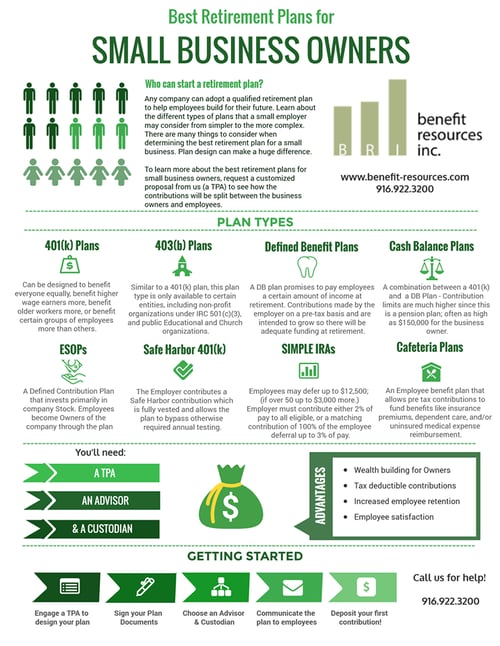Retirement plans are not just for Fortune 500 companies! Any type and any size company can adopt a qualified retirement plan to help employees build for their future. This is a short overview of different types of plans that a small employer may consider listed from simplest to most complex. There are many things to consider when determining the best retirement plan for a small business. Plan design can make a huge difference.

SEP IRA
Eligibility: An employee joins the plan at the beginning of the third calendar year of employment as long as he or she earned at least $550 in pay for each of those calendar years, and is age 21.
Contributions: Employers may contribute up to 25% of pay, or $49,000. All eligible employees receive the same percentage of pay. No employee contributions are made to a SEP. Contributions must be deposited by the due date of the sponsoring employer’s income tax return.
Investments: An IRA is established for each eligible employee. Contributions are made to that IRA, and are 100% vested at all times.
Distributions: Participant may withdraw funds from IRA at any time. Taxes apply, and excise taxes apply if under age 59 ½; some exceptions to excise taxes are available.
Filings: No Form 5500 filing is required
Deadline: By due date of employer’s tax return.
SIMPLE IRA
Eligibility: An employee joins the plan at the beginning of the third calendar year of employment as long as he or she earned at least $5,500 in pay for each of those calendar years, and is age 21.
Contributions: Employees may defer up to $11,500; those over age 50 can contribute an additional $2,500 catch up. Employers must contribute either 2% of pay to all eligible employees, or a matching contribution of 100% of the employee deferral up to 3% of pay. Deferrals must be deposited each pay period; Employer contributions must be deposited by the due date of the sponsoring employer’s income tax return.
Investments: An IRA is established for each eligible employee. Contributions are made to that IRA, and are 100% vested at all times.
Distributions: Participant may withdraw funds from IRA at any time. Taxes apply. Excise tax of 25% if withdrawn in first 2-years.
Filings: No Form 5500 filing is required
Deadline: By October 1 for existing businesses; as soon as possible for new businesses. This can be the only plan of the employer, and is only available to businesses with fewer than 100 employees.
Schedule a free consultation to go beyond the basics here. We can help guide you to the best plan for your particular company.
401(k) PROFIT SHARING
Eligibility: Employees can be required to work 1000 hours in their first 12-months, and be at least age 21 before being eligible for the plan. Entry into the plan can be immediate, monthly, quarterly or semi-annually
Contributions: Employees may defer up to $16,500; those age 50 and over can contribute an additional $5,500 catch up. Employee contributions may be Roth or pre-tax. Maximum of all deposits cannot exceed $49,000 per year ($54,500 with catch up).
Employers may contribute either a matching contribution and/or a Profit Sharing contribution. A variety of formulas can be used for either of these contributions and can be designed to benefit everyone equally, benefit higher wage earners more, benefit older workers more, or benefit certain groups of employees more than others. These offer a great deal of flexibility.
Deferrals must be deposited each pay period; Employer contributions must be deposited by the due date of the sponsoring employer’s income tax return.
Investments: Accounts are all registered to the name of the plan. Those accounts may be participant-directed or trustee-directed or both. Employer contributions may be subject to a vesting schedule up to 6-years long.
Distributions: Participant must suffer “triggering event” before allowed to withdraw funds (retirement, termination, death, or disability). Hardship withdrawals, in-service withdrawals, and/or loans may be made available.
Filings: Form 5500 filing is required 7-months after the end of the plan year. The 5500 filing and compliance testing is provided by TPA.
Deadline: Plan documents must be adopted by the last day of the plan year. Deferrals cannot begin
until documents are signed. Plans may be run on calendar or fiscal year.
CASH BALANCE PENSION PLAN
Eligibility: Employees can be required to work 1000 hours in their first 12-months, and be at least age 21 before being eligible for the plan. Entry into the plan can be monthly, quarterly or semi-annually.
Contributions: Employer contributes a “pay credit” (percentage of pay or flat dollar amount) and an “interest credit” (typically 4%-5%) to each eligible employee’s account each year. These are mandatory contributions for a minimum of 5 years. Contribution limits are much higher since this is a pension plan; often as high as $150,000 for the business owner. Employer contributions must be deposited by the due date of the sponsoring employer’s income tax return.
Investments: Accounts are all registered to the name of the plan. Those accounts are always trustee-directed. Employer contributions may be subject to a 3-year cliff vesting schedule.
Filings: Form 5500 filing is required 7-months after the end of the plan year. The 5500 filing and compliance testing is provided by an actuary and TPA.
Deadline: Plan documents must be adopted by the last day of the plan year. Plans may be run on calendar or fiscal year. Cash Balance plans are often combined with a 401(k) Profit Sharing plan to maximize the benefit to the business owner.
To learn more about the best retirement plans for small business owners, request a customized proposal from us to see how the contributions will be split between the business owners and employees. Retirement plans are one leg of financial planning’s three-legged stool, so get started as soon as you can, and deposit as much as you can so that you and your employees will be able to enjoy a comfortable retirement.
